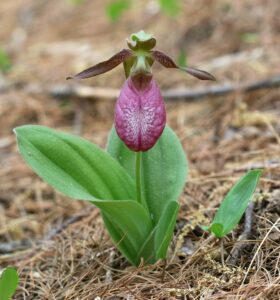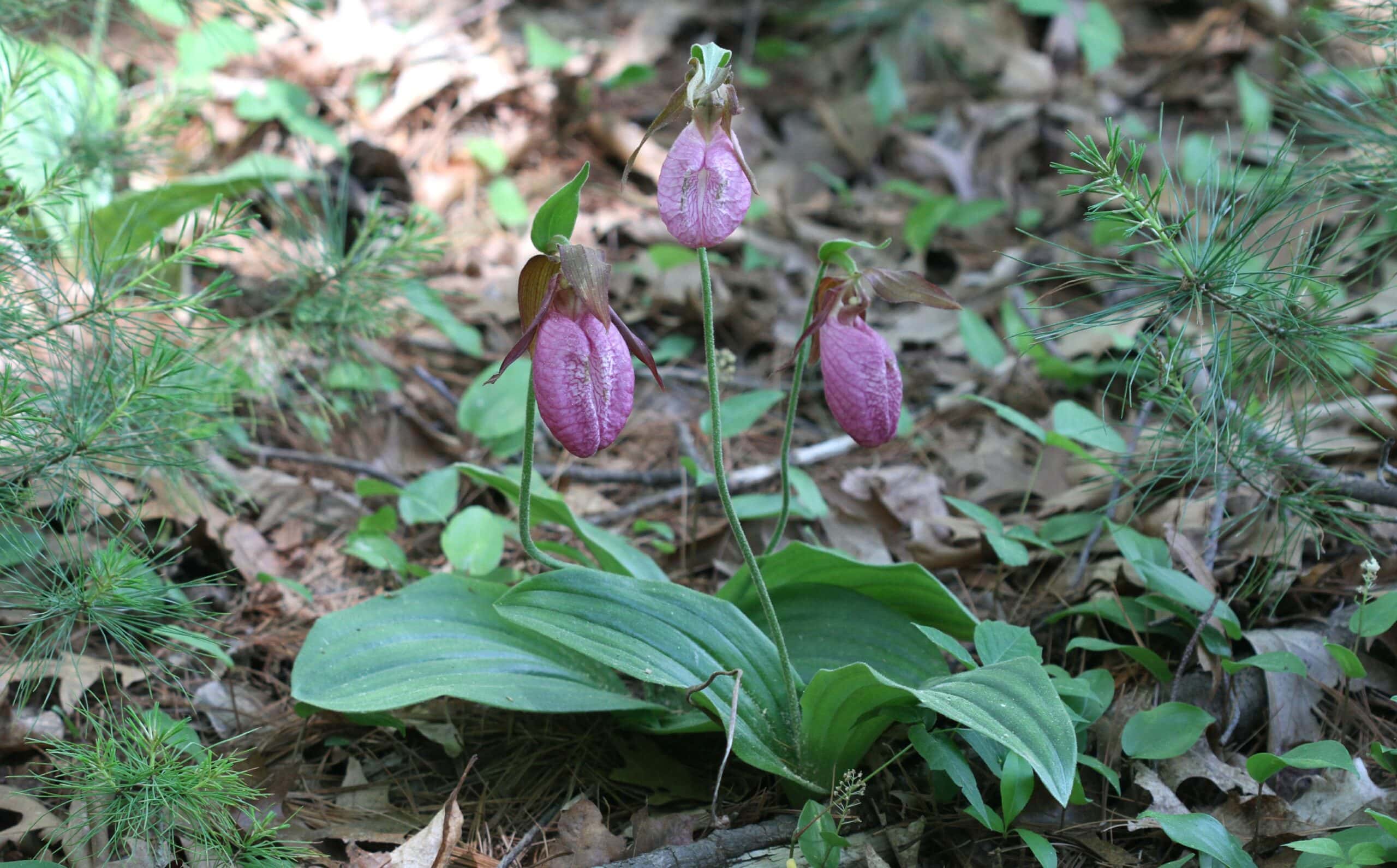
You might be familiar with orchids as the flowers in corsages or as exotic store-bought houseplants, but did you know that wild orchids grow in the woods of Massachusetts? In our area, they include a native orchid with a large, single slipper-like blossom as well as a potentially invasive orchid with multiple small flowers.
Pink lady’s slipper (Cypripedium acaule), also called moccasin flower, is perhaps the crown jewel of our local wildflowers. It’s also neighboring New Hampshire’s state wildflower. This showy orchid gets its name from its large, pink slipper- or moccasin-shaped blossom with brown “shoestrings” above it. Look for pink lady’s slippers in the shadowy environment of woods with pines, either all pine or a mix of pines and hardwood trees. Pink lady’s slippers need the highly acidic soil that is typical of these woods, as well as specific fungi that grow in this soil. These orchids bloom for about two weeks in late May-early June, depending on the weather. Memorial Day is almost always a great time to find pink lady’s slippers.
Helleborine, or broad-leaved helleborine (Epipactis helleborine), is a potentially invasive non-native orchid that you might be surprised to find growing in your lawn or garden in summer. It bears numerous intricate flowers that are ½ to ¾ inch wide. They can be pale yellow, green, pink, or reddish purple. Helleborine flourishes in a variety of shady or partly shady environments, from roadsides and woodland edges to woods with hardwood trees to gardens and lawns. Near homes or former farm lands, helleborine benefits from fertilizer and treatments that make the soil “sweeter” – less acidic – than usual around here. It was first introduced from Europe to Syracuse, N.Y., in 1879. It can spread aggressively in some places, although it is not officially listed as invasive in Massachusetts.
Why do people think orchids are so special? One reason is that orchids are uncommon in our area. Most of the approximately 28,000 plants in the orchid family grow in the tropics, but Massachusetts has only about 45 orchid species.
The delicate, fancy-looking flowers of orchids make them special to many people. Not only do orchid blossoms look lovely and interesting, but they are also set up in interesting ways for pollination. Most orchid flowers package their pollen in large sticky clumps. Instead of dusting their pollinators with pollen, as so many other flowers do, orchids stick pollen clumps onto pollinators. When the right-sized bee, wasp, fly, or other pollinator investigates an orchid flower, the pollen clumps stick to parts of the insect’s body and stay there until these clumps get scraped off by the next blossom of the same kind of orchid.
Pink lady’s slipper blossoms are a good example. They are pollinated by bumblebees, which are big and strong enough to push into the pouch-like slipper blossom through a slit down the middle. Once inside, there’s no room for turning around, so the bumblebee can leave only by pushing its way through the interior of the blossom to the exit at the back. Along the way, the bumblebee rubs against various flower parts. First it passes under the female flower part (stigma) which scrapes off pollen clumps from previous flowers. Then the bee pushes past male flower parts (anthers), picking up new pollen clumps. This arrangement is not the same for all orchid flowers, but the pattern of events is similar.
Helleborine’s smaller blossoms are more open, with a bowl-shaped lower petal that serves as a landing pad for pollinators, typically various wasps. Helleborine blossoms produce nectar containing a variety of chemicals that attract insects, including scented chemicals, chemicals that attract aphid-eating and other wasps, and chemicals that appear to intoxicate insects. (Watch wasps pollinating helleborine: https://www.youtube.com/watch?v=9fYlFjL_T1E;https://www.youtube.com/watch?v=NOyIwKZl4dU.)
Orchids also have crucial relationships with fungi that grow in the soil that suits the orchid. For this reason, pink lady’s slippers are notoriously difficult to transplant (don’t even try) or grow from seed. Why? Nutrients supplied by connections with certain underground fungi help the plants grow. Pink lady’s slippers especially need just the right specific fungi to help their seeds germinate and grow. Their dust-like seeds are so small that they don’t contain nourishment for early stages of growth, but instead, get what they need through connections with the right fungi. Helleborine has similar needs, but forms relationships with a wider range of fungi than pink lady’s slipper, so it’s more of a generalist in its associations with fungi (as well as in its associations with pollinators).
Once established, both orchids are long-lived perennials. Pink lady’s slippers can survive up to 20 years. The main risks to wild orchids in Massachusetts continue to be collecting (no picking or digging!) and habitat destruction through development.
If you’re lucky enough to spot any of Massachusetts’ wild orchids, think of them as wonderful examples of the interconnectedness of the natural world, and appreciate their special relationships – specific or general – with pollinators and underground fungi.
***
Nature Notes is written for the Westborough Community Land Trust and re-published online by the Community Advocate.
***
What else might you see outside in nature these days? Check out the WCLT Nature Notes articles listed for these months in our online monthly index.
Did you know that Westborough has 60 miles of trails, and WCLT has trail maps? The Westborough Community Land Trust (WCLT) preserves, protects, and promotes open space in Westborough (westboroughlandtrust.org and facebook.com/westboroughlandtrust).













